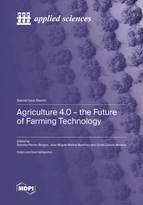Agriculture 4.0 – the Future of Farming Technology
A special issue of Applied Sciences (ISSN 2076-3417). This special issue belongs to the section "Agricultural Science and Technology".
Deadline for manuscript submissions: closed (20 September 2023) | Viewed by 46389
Related Special Issue: Applications of Remote Image Capture System in Agriculture
Conferencing Partner: III Symposium Ibérico de Ingeniería Hortícola 2022 Smart Farming
Special Issue Editors
Interests: industrial design in agriculture; augmented/virtual reality; CAD
Special Issues, Collections and Topics in MDPI journals
Interests: water resources management; irrigation; energy efficiency; smart agriculture; agriculture automation and control; computers and electronics in agriculture
Special Issues, Collections and Topics in MDPI journals
Interests: computer vision; image processing in agriculture; pattern recognition
Special Issues, Collections and Topics in MDPI journals
Special Issue Information
Dear Colleagues,
At present, the agricultural sector is experiencing a new revolution that is opening up novel research perspectives. The term “Agriculture 4.0” refers to an innovative way of understanding agriculture, where new tools and technologies not traditionally used in this sector can coexist. The use of different kinds of sensors and the collection of large amounts of data through the internet, analyzed in real time or offline, offer a wide variety of effective and efficient solutions for managing agricultural crops, optimizing resources, and improving agronomical decisions. Manuscripts covering the following technologies applied in agriculture are invited to the present Special Issue:
- Internet of things (IoT);
- Sensors and sensor networks;
- Electronic equipment and devices;
- Communications networks;
- Artificial intelligence;
- Computer vision;
- Use of drones and remote sensing;
- Automation and control;
- Precision farming;
- Mechanization and agricultural robotics;
- Technologies for the management of agricultural resources and the environment;
- Desalination for use in agriculture;
- Renewable energies;
- APPs;
- Cloud computing;
- Big data;
- Traceability;
- Online platforms for the management of agri-food processes;
- Software for agriculture;
- Design, 3D modeling and augmented/virtual reality.
Dr. Dolores Parras-Burgos
Prof. Dr. José Miguel Molina Martínez
Prof. Dr. Ginés García-Mateos
Guest Editors
Manuscript Submission Information
Manuscripts should be submitted online at www.mdpi.com by registering and logging in to this website. Once you are registered, click here to go to the submission form. Manuscripts can be submitted until the deadline. All submissions that pass pre-check are peer-reviewed. Accepted papers will be published continuously in the journal (as soon as accepted) and will be listed together on the special issue website. Research articles, review articles as well as short communications are invited. For planned papers, a title and short abstract (about 100 words) can be sent to the Editorial Office for announcement on this website.
Submitted manuscripts should not have been published previously, nor be under consideration for publication elsewhere (except conference proceedings papers). All manuscripts are thoroughly refereed through a single-blind peer-review process. A guide for authors and other relevant information for submission of manuscripts is available on the Instructions for Authors page. Applied Sciences is an international peer-reviewed open access semimonthly journal published by MDPI.
Please visit the Instructions for Authors page before submitting a manuscript. The Article Processing Charge (APC) for publication in this open access journal is 2400 CHF (Swiss Francs). Submitted papers should be well formatted and use good English. Authors may use MDPI's English editing service prior to publication or during author revisions.
Keywords
- agricultural engineering
- precision agriculture
- agromotics
- computer science in agriculture
- remote sensing
- information and communication technologies in agronomy








